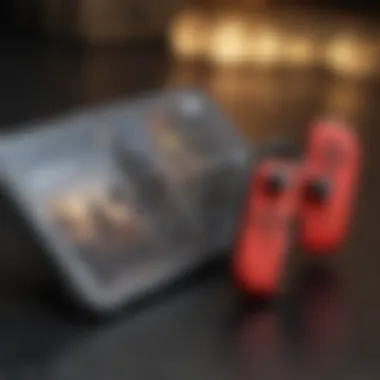SD Card Games for Nintendo Switch: A Complete Guide


Intro
In the current gaming landscape, the Nintendo Switch has distinguished itself as a versatile platform for gamers. Its ability to support a vast library of games, combined with the option to expand storage using SD cards, makes it a noteworthy choice for players seeking flexibility and variety. This article delves into the myriad SD card games available for the Nintendo Switch, focusing on genres, key titles, and storage considerations. By examining these aspects, we hope to guide gamers in making informed choices that enhance their gaming experiences.
Overview of SD Card Games
The range of games accessible through SD cards on the Nintendo Switch encompasses various genres, including action, adventure, role-playing, and indie games. Notable titles enhance the gaming environment by providing immersive experiences across different themes and gameplay mechanics.
Switch games such as The Legend of Zelda: Breath of the Wild, Stardew Valley, and Hollow Knight display how the platform accommodates different gaming preferences, from epic quests to charming farming simulations and challenging platformers.
This diverse selection offers players the opportunity to tailor their gaming library to their tastes, while the use of SD cards provides additional benefits. With SD cards, players can expand storage beyond the device's internal memory, thus allowing for the installation of more games and updates.
Storage Considerations
Effective management of storage is crucial for a seamless gaming experience. The Nintendo Switch supports various SD card capacities, from 64GB up to 2TB, which not only impacts how many games can be stored but also influences load times and performance. Players should consider their gaming habits when selecting an appropriate storage option.
Advantages of using SD cards include:
- Increased game library capacity
- Faster data access compared to the internal memory in some cases
- Convenience and portability
For optimal performance, it is advisable to choose high-speed SD cards, such as those rated UHS-I or UHS-II. These cards are engineered for faster read and write speeds, thus enhancing gameplay fluidity.
Digital vs. Physical Formats
The debate between digital downloads and physical cartridges persists among gamers. Utilizing SD cards tilts this discussion toward digital formats, allowing for seamless access to titles without the need for physical storage. While digital games require an initial investment in storage, they often come with the advantage of ease of access and automatic updates.
Physical cartridges, conversely, offer a tangible collectible aspect. Some players enjoy the nostalgia of physical ownership, even if they face storage limitations with the Switch’s internal memory. Both formats have their merits, and understanding personal preferences will guide players in selecting the right approach.
End
The world of SD card games for the Nintendo Switch is rich and varied. With countless titles available across multiple genres, players can develop a library that reflects their unique tastes. In considering storage options, examining digital versus physical formats, and understanding game capacity, gamers become empowered to enhance their play experiences. By optimally managing these aspects, one can truly unlock the full potential of the Nintendo Switch gaming library.
"Choosing the right SD card can significantly influence the gaming experience, enhancing loading times and allowing for more immersive gameplay."
Thus, exploring SD card games isn’t merely about the number of titles available but how to integrate them effectively into the gaming lifestyle.
Preface to SD Card Gaming on Nintendo Switch
As the Nintendo Switch continues to thrive in the gaming market, it has become increasingly important for players to understand the role of SD cards in enhancing their gaming experience. SD cards are vital for expanding storage on the Nintendo Switch, as the console's built-in memory can be limited for avid gamers. This article aims to illuminate the significance of SD card gaming on the Switch, emphasizing how it can impact game selection, performance, and overall enjoyment.
Understanding SD Card Usage
The use of SD cards in gaming facilitates a flexible storage solution. Unlike physical copies, digital games occupy disk space. With many popular titles available, gamers often find themselves running out of space on their internal memory. This is where SD cards come into play.
When selecting an SD card for the Nintendo Switch, one must consider compatibility and speed. The Switch supports microSD, microSDHC, and microSDXC formats. Games can be easily transferred to and from the card, providing convenience when managing a library of games. For smooth performance, choose a UHS-I card, which offers faster read and write speeds—critical for loading games efficiently.
Importance of Storage Capacity
Understanding storage capacity is essential for any gamer looking to utilize SD cards effectively. The capacity of an SD card can substantially affect gameplay and accessibility. For casual players, a smaller card may suffice. However, for those wanting numerous titles or large games, investing in a higher-capacity card is prudent.
Storage capacity also directly influences performance metrics, including loading time and speed during gameplay. If a card becomes too full, it may slow down. Keeping this in mind, regular monitoring and management of storage can help maintain optimal game performance and user satisfaction.


“The right SD card can transform your Nintendo Switch experience, making it smoother and more enjoyable.”
To summarize, having a firm grasp of SD card usage and the importance of storage capacity will empower players to optimize their Nintendo Switch. Effective management of digital content leads to better game performance and an enhanced gaming experience.
Types of SD Cards Compatible with Nintendo Switch
Understanding the types of SD cards that are compatible with the Nintendo Switch is essential for gamers who want optimal performance and storage. The Nintendo Switch has limitations in terms of the kind of SD cards it supports. Knowing the specifics can prevent frustration and ensure that players can store their favorite games without issues.
Standards and Specifications
SD cards for the Nintendo Switch must meet specific standards to ensure they work correctly. The Switch supports microSD, microSDHC, and microSDXC formats. Each of these has distinct characteristics:
- microSD: These cards can typically hold up to 2GB of data and are the least common for the Switch since modern games often require more storage.
- microSDHC: This format allows for storage capacities of 4GB to 32GB. While more capable than microSD, it still may not suffice for a comprehensive game library.
- microSDXC: These are the most recommended for Nintendo Switch users, as they support storage from 32GB up to 2TB. This wide range makes them suitable for many game installations and related data.
It is also vital to notice the class rating of these SD cards. Class 10 cards are preferable as they typically offer minimum write speeds of 10 MB/s, which is essential for smooth gameplay without interruptions or slow load times. Some cards also feature UHS-I (Ultra High Speed), which provides even better performance under heavy data load.
Recommended Brands
When it comes to choosing an SD card for the Nintendo Switch, not all brands are equal. Some brands have established reputations for reliability and performance:
- SanDisk: Their extreme versions are often recommended for gamers, providing excellent speed and durability.
- Samsung: Known for their EVO line, they offer great performance and a variety of storage options.
- Lexar: They also produce high-quality cards that are compatible with the Switch, balancing performance and price.
It's wise to look for cards labeled specifically for gaming to ensure compatibility and performance. Users should also visit forums like Reddit for personal recommendations and performance reviews by fellow gamers.
Featured SD Card Games for Nintendo Switch
The selection of featured SD card games for the Nintendo Switch is crucial in enhancing the gaming experience. The availability of diverse titles allows players to explore various genres like RPG, action, and indie games. Each game offers unique mechanics and narratives, which can be enriched by the fast loading times often associated with SD card storage. This flexibility lets users adjust their gameplay according to personal preferences, making SD cards not just a storage solution, but a gateway to immersive experiences.
RPG Titles Worth Noting
When it comes to role-playing games (RPGs), the Nintendo Switch has several standout titles that benefit significantly from SD card usage. Games such as The Witcher 3: Wild Hunt and Fire Emblem: Three Houses are noteworthy. These titles often require extensive storage due to their rich graphics and complex storylines. Using an SD card can allow for quicker loading times and smoother transitions between scenes, enhancing overall immersion. Moreover, having the option to store multiple RPGs on the SD card allows players to manage their game library efficiently, switching between different worlds as desired.
Action and Adventure Games
Action and adventure games also thrive on the Nintendo Switch. Titles like Zelda: Breath of the Wild and Hollow Knight exemplify how storage capacity can influence player engagement. Using high-capacity SD cards to store these games can assure faster loading times, which is vital in high-paced environments where timing is everything. Players can engage more fully with the gameplay, experiencing fewer interruptions. Additionally, this convenient storage solution enables gamers to explore additional downloadable content that further expands the gaming horizon.
Puzzle and Strategy Games
In the realm of puzzle and strategy games, versatility holds significant merit. The Witness and Civilization VI are excellent examples of titles that utilize strategic thinking and problem-solving. The ability to keep these games stored on an SD card allows players to dive back into intricate puzzles or complex strategies anytime without having to manage limited internal storage continuously. This is especially important for gamers who relish alternating their activities between different game styles. With SD cards, the barrier between genres is diminished.
Indie Games of Interest
Indie games have become a pivotal part of the Nintendo Switch ecosystem. Titles such as Celeste and Stardew Valley demonstrate creativity and innovation. These games often have smaller file sizes but provide rich content that captivates players. Utilizing SD cards for these indie games means players can keep a library of various innovative titles without sacrificing precious storage on their device. Furthermore, indie developers often release updates and expansions, making it practical to store these games on SD cards to accommodate new content without overwhelming the system's internal space.
Utilizing SD cards effectively allows Switch owners to expand their gaming experience beyond the constraints of internal memory, encouraging exploration across a spectrum of titles.
Overall, featured SD card games for the Nintendo Switch deliver diverse gaming potential. Each genre offers distinct gameplay elements, making SD cards a valuable asset for any gamer looking to optimize their experience.
Evaluating Game Performance with SD Cards
When discussing SD cards for gaming on the Nintendo Switch, evaluating game performance is essential. Performance can profoundly influence the gaming experience. Various elements come into play, which we will explore in this section. Understanding these aspects allows players to maximize their enjoyment and efficiency while using SD cards.


Loading Times and Gameplay Smoothness
Loading times are one of the most noticeable factors affecting performance. A faster SD card can significantly reduce how long a player must wait before getting into the action. For instance, some high-speed SD cards can load games in seconds, while slower options might take much longer. This delay can be frustrating, especially in fast-paced games where every second counts.
Gameplay smoothness also hinges on SD card performance. Games that constantly fetch data from storage may lag or stutter if the SD card cannot keep up with the demand. Games with open worlds or extensive assets are particularly susceptible to these issues. Therefore, choosing an SD card with high read and write speeds can lead to a more seamless gaming experience.
"Gaming performance is as much about storage speed as it is about the console itself."
Using a card that meets or exceeds the Nintendo Switch's recommended specifications is beneficial. For best results, gamers should aim for UHS-I (Ultra High Speed) cards, as they tend to provide the necessary bandwidth for modern game titles. It is worthwhile to research before purchasing to ensure an optimal balance between price and performance.
Effects of Storage Capacity
Storage capacity plays a critical role in game performance. A larger capacity SD card allows players to store more games; however, it also directly affects how data is managed. When nearing the storage limits of a card, the performance may degrade. Games may take longer to locate data, causing increased loading times.
Here are some considerations regarding storage capacity:
- Choosing the Right Size: Depending on gameplay habits, a 64GB or 128GB card might suffice for casual gamers, while heavy users may need 256GB or more.
- Usage Patterns: Regularly playing multiple large titles can fill up space fast. Gamers must assess their needs and future gaming plans.
- Maintenance: Deleting unneeded files helps free up space and can improve performance. Regularly maintaining an SD card ensures smooth operation and avoids common storage-related bottlenecks.
Digital vs Physical Games: A Closer Look
In the context of gaming on the Nintendo Switch, understanding the differences between digital and physical games is crucial for making informed decisions. The choice between these two formats influences not only the gaming experience but also storage management and convenience. Digital games come with distinct advantages like ease of access and automatic updates, while physical copies provide a tangible collection and potential resale value.
Pros and Cons of Digital Games
Digital games offer several compelling benefits:
- Instant Access: Upon purchase, digital games are readily available for download. Players can jump right into their new titles without waiting for shipping or visiting a store.
- Automatic Updates: Digital games often receive patches and updates automatically, ensuring the player always has the latest version.
- No Physical Space Required: With digital games, there is no need to worry about shelf space or organizing cartridges.
However, some drawbacks exist:
- Dependency on Storage: Digital games require sufficient SD card capacity. If storage is full, players might need to delete titles to make room for new ones.
- No Resale or Trade: Digital licenses are typically tied to the user's account, which means players cannot sell or trade digital copies.
- Internet Connection Needed: While many games can be played offline once downloaded, a good internet connection is often required for initial downloads or updates.
The Case for Physical Copies
Physical copies of games have remained popular for various reasons:
- Tangible Ownership: Owning a physical game provides a sense of permanence. Many players appreciate having a physical copy on their shelves, allowing them to revisit their collection anytime.
- Resale Value: Physical games can be sold or traded, offering an avenue for recouping some costs. This can be especially useful for gamers who frequently explore new titles.
- Collector’s Appeal: Special editions and boxed sets appeal to collectors. These often contain bonus content, making them desirable.
Nevertheless, there are considerations to keep in mind:
- Physical Space Needed: Physical copies occupy space, which may become an issue for players with extensive collections.
- Limited Availability: Sometimes, physical editions become hard to find, especially for indie games or limited runs.
- No Automatic Updates: Physical copies require manual updates, which can be a hassle if players forget to download patches and updates.
The digital versus physical debate is ongoing, with strong arguments on both sides. Gamers need to weigh their preferences against storage considerations, resale values, and the overall gaming experience.
In summary, choosing between digital and physical games involves understanding personal preferences and how each format aligns with one's gaming habits. Whether one prioritizes convenience, resale potential, or collecting, this choice significantly shapes the Nintendo Switch gaming experience.
Managing Your SD Card Storage
Managing your SD card storage is crucial for optimal gameplay on the Nintendo Switch. The console relies heavily on external storage for downloadable games and updates, placing a premium on how effectively you manage available space. Poor storage management can lead to frustrating experiences such as long loading times, limited accessibility to your game library, and an overall subpar gaming experience. Here we will discuss two essential aspects of managing your storage: transferring games and deleting unused files.
Transferring Games to and from SD Cards


Transferring games between your internal storage and SD cards can enhance your gaming experience. This process allows you to prioritize the games you play most often while freeing up space for new titles. The Nintendo Switch offers an intuitive method for this:
- Access System Settings: Navigate to the home screen, select the gear icon for settings.
- Data Management: Under the data management section, you can view both internal storage and the SD card capacity.
- Manage Software: Select your games and choose options to move them to the SD card or internal memory.
This flexibility ensures that you can access high-priority titles quickly. Additionally, it helps maintain the speed and performance of games stored on the SD card. Putting bigger games or those you play less often on the SD card can also save space for smaller retro titles you may wish to keep handy.
Deleting Unused Games and Files
As your library grows, it's easy to accumulate games and files you no longer need. Periodically deleting unused games or files is necessary to optimize your SD card storage. Here’s how to do it effectively:
- Review Your Library: Begin by evaluating your collection. Identify titles you have not played in a while.
- Deletion Process: Go back to the system settings, find the data management section, and select the games or applications you wish to delete.
- Consider Saving Data: Ensure you back up any important save data before deleting games, as they may be lost permanently.
Deleting unused titles not only clears space but also streamlines your gaming experience. A well-managed storage system will keep your Switch running smoothly and make it easier to navigate through your titles.
"Regular management of your SD card can save time and reduce headaches, ultimately leading to a more enjoyable gaming experience on the Nintendo Switch."
Properly managing your SD card can greatly enhance your gaming experience, allowing improved game accessibility, streamlined performance, and keeping your gaming library organized.
Future of SD Card Gaming on Nintendo Switch
The evolution of gaming technology continues to shape the landscape of how gamers store and interact with their games. In this light, the future of SD card gaming for the Nintendo Switch holds significant relevance. As titles grow larger in size and complexity, the need for expansive and efficient storage solutions becomes paramount. This trend makes it essential for players to stay informed about upcoming developments in both game design and storage technology.
Upcoming Trends in Game Development
The gaming industry is marked by rapid change, and several trends stand out. First is the trend toward bigger game worlds and immersive experiences. As developers create more content-rich games, the average file size tends to increase. Open-world RPGs or graphically intensive action games that rely on detailed environments will likely demand more storage space. This challenges gamers since standard game cartridges or smaller SD cards may not suffice.
Next, we see a growing interest in downloadable content and expansions. Games are no longer static after purchase. With updates, seasonal content, and DLCs, the storage requirement can easily balloon beyond initial expectations. Games like The Legend of Zelda: Breath of the Wild provide ongoing updates and add-ons that ensure players remain engaged. Players must consider this when selecting SD cards, opting for larger capacities in anticipation of future downloads.
Finally, cross-platform integration is gaining momentum. Multiplayer experiences that span across various consoles or devices introduce new complexities in storage management. Players will need to learn how to manage not only their own game library but also files associated with online accounts. SD cards that seamlessly integrate with multiple platforms will gain prominence, and understanding compatibility helps players make informed choices.
Technological Advances in Storage Solutions
Technological improvements in storage solutions foster a positive outlook. Faster read and write speeds in new SD card models promise reduced loading times, enhancing game performance significantly. Brands like SanDisk and Samsung are innovating their products, with cards that support UHS-II specifications gaining popularity. These can dramatically speed up the loading process, crucial for maintaining gameplay fluidity during high-octane action scenes.
Another noteworthy development is the integration of cloud storage solutions. While not a direct substitute for SD cards, services like Nintendo Switch Online offer cloud backups for saved data. This enables gamers to free up space on their SD cards while keeping essential game data secure. Understanding the synergy between physical and cloud storage will become increasingly relevant.
Furthermore, the affordability of higher-capacity cards continues to improve. As manufacturers ramp up production and competition increases, consumers benefit from lower prices for larger storage options. This affordability encourages players to invest in more robust SD cards that accommodate their gaming preferences.
In summary, understanding the future of SD card gaming on the Nintendo Switch helps players prepare for changes in game size, storage technology, and the evolving landscape of game development. An informed choice in SD cards can enhance the gaming experience considerably.
The End and Recommendations
The discussion on SD cards for the Nintendo Switch culminates in understanding the significant role they play in the gaming landscape. As portable gaming has matured, storage solutions have also evolved, making SD cards vital for gamers who wish to expand their collection without restrictions. This conclusion emphasizes the key aspects of making informed decisions when purchasing and utilizing SD cards, ensuring an optimal gaming experience.
Making Informed Purchasing Decisions
When selecting an SD card for the Nintendo Switch, it is crucial to consider various elements that affect both functionality and long-term usability. Key factors include:
- Compatibility: Ensure the SD card meets the technical specifications required by the Switch, supporting at least the UHS-I standard for optimal performance.
- Storage Size: Determine how many games you intend to download. A minimum of 128GB is often recommended, but higher capacities may be necessary for larger libraries.
- Read and Write Speeds: Look for cards that offer fast read and write speeds. This will enhance loading times and overall gameplay smoothness.
Investing in a quality SD card is as important as the game itself. Read reviews and seek recommendations from fellow gamers. Understanding your gaming habits can guide you to the right choice.
Final Thoughts on SD Cards and Gaming
SD cards have redefined how players interact with their Nintendo Switch consoles. Not only do they offer the opportunity to store multiple game titles, but they also ensure players can enjoy their library with ease and efficiency. The freedom and flexibility provided by SD cards enhances the gaming experience significantly.
"Utilizing an SD card transforms your Switch into a more versatile gaming platform, making it possible to explore a vast library of titles without ever needing to delete your favorite games."
In summary, the benefits of using SD cards outweigh any potential downsides. Prioritize reliable brands and familiarize yourself with capacity options. Embrace the convenience they provide, and your gaming sessions will undoubtedly become more enjoyable.















